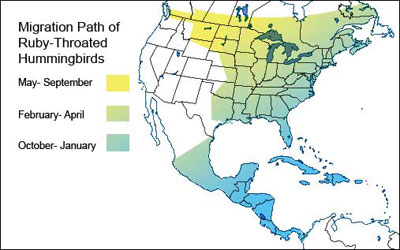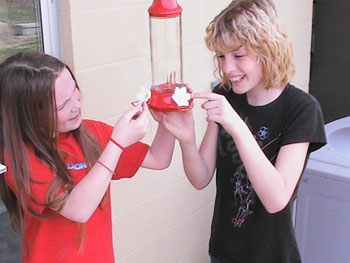Stars and STEM Stories
Students in Norfork, Arkansas Predict the Arrival Date of Ruby-Throated Hummingbirds in their Migration Path North
At Norfork Elementary School in Norfork, Arkansas, Wade Geery, a trained GLOBE teacher, and his sixth grade students are anxiously waiting for the arrival of the first Ruby-throated Hummingbird, on the birds' spring migration path from Central America to Canada. The students have been collecting data on the Ruby-throated Hummingbirds for the past two years: observing the first arrival dates of each gender, noting the relative number of hummingbirds throughout each season, observing what flowers the birds visit and noting the departure date of the last hummingbird in the birds' fall migration to Central America. The hummingbirds settle in Southern Mexico and Northern Panama during winter after migrating across the Gulf of Mexico. The birds return to the United States and Canada during the spring and summer seasons.

The students' data is compiled for Operation RubyThroat: The Hummingbird Project, an international initiative, started in 1999 by Bill Hilton, to study the behavior and distribution of Ruby-throated Hummingbirds through collaboration between students, teachers, and others. The Hilton Pond Center for Piedmont History in York, South Carolina, has been the headquarters for Operation RubyThroat. Participants of all ages live in the United States, Canada, Mexico and Central America, countries where the Ruby-throated Hummingbird regularly appears. In 2001, "Operation RubyThroat" partnered with GLOBE to implement hummingbird protocols in about 50 schools across 38 states. Teachers from these schools have attended GLOBE certification workshops to learn animal behavior protocols to assist in their observations of birds.
Bill Hilton has worked with diverse student populations along the migration path. He has found that some students, particularly in urban areas, have never heard of a hummingbird and are unaware of what the creature looks like. For those students, this program has given them an awareness of the diversity that exists within their global environment.

At Norfork Elementary, GLOBE students have developed the skills to hypothesize and draw conclusions based on their observations of the birds in their habitat. Last fall, during the hummingbird migration, students were able to identify specific birds according to their unique plumage. Also, the students have learned to identify the differences between male and female hummingbirds. Bill Hilton uses the data collected to look for trends, correlating climate change to hummingbird population and migration. Factors such as land cover, rising temperatures, and natural disasters can alter the hummingbird populations and migration paths from season to season. Thus, the data submitted by the GLOBE students provides insight into the larger issue of global climate change and its effects on the environment.
Wade Geery, a science teacher at Norfork Elementary, believes that, "for students to understand science, they have to experience (and behave like) scientists. It is not enough to teach the nature of science. Experience is the greatest teacher." He has challenged his students to predict the date when the first Ruby-throated Hummingbird will arrive this spring. The students are encouraged to research any accessible data such as local newspapers, other media, folklore, and GLOBE data compiled from the past two years. The winning student with the closest prediction to the actual arrival date will receive a gift certificate to a local store. Tessa J. wrote, "I chose the date of 14 May because that is the day before my birthday and I remember looking at hummingbirds that day (last year)." Jacob S. said he chose the 14th of April because "I looked in the Almanac, talked to my Grandpa, and looked on the internet."
26 April 2007





